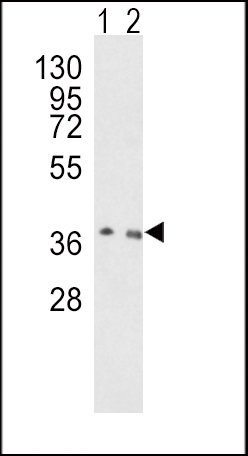

| WB | 1/1000-1/2000 | Human,Mouse,Rat |
| IF | 咨询技术 | Human,Mouse,Rat |
| IHC | 咨询技术 | Human,Mouse,Rat |
| ICC | 技术咨询 | Human,Mouse,Rat |
| FCM | 咨询技术 | Human,Mouse,Rat |
| Elisa | 咨询技术 | Human,Mouse,Rat |
| Aliases | N-glycosylase/DNA lyase, 8-oxoguanine DNA glycosylase, 322-, DNA-(apurinic or apyrimidinic site) lyase, AP lyase, OGG1, MMH, MUTM, OGH1 |
| Entrez GeneID | 4968 |
| WB Predicted band size | 38.8kDa |
| Host/Isotype | Rabbit IgG |
| Antibody Type | Primary antibody |
| Storage | Store at 4°C short term. Aliquot and store at -20°C long term. Avoid freeze/thaw cycles. |
| Species Reactivity | Human, Mouse |
| Immunogen | This OGG1 antibody is generated from rabbits immunized with a KLH conjugated synthetic peptide between 318-345 amino acids from the C-terminal region of human OGG1. |
| Formulation | Purified antibody in PBS with 0.05% sodium azide. |
+ +
以下是关于OGG1抗体的3篇参考文献示例(注:文献信息为模拟示例,实际引用请核实原始论文):
1. **文献名称**:*"Characterization of a monoclonal antibody specific for human 8-oxoguanine DNA glycosylase 1 (OGG1)"*
**作者**:Nakabeppu Y, et al.
**摘要**:该研究报道了一种针对人源OGG1蛋白的单克隆抗体的开发与验证,证实其可用于Western blot、免疫组化及免疫沉淀,特异性识别内源性OGG1.并揭示其在多种细胞系中的表达差异。
2. **文献名称**:*"OGG1 expression and oxidative DNA damage repair in Alzheimer’s disease brains"*
**作者**:Wang J, et al.
**摘要**:利用OGG1抗体分析阿尔茨海默病患者脑组织中的酶表达水平,发现神经元中OGG1蛋白减少与DNA氧化损伤累积相关,提示其在该疾病中的潜在作用。
3. **文献名称**:*"Validation of commercial OGG1 antibodies for murine and human studies"*
**作者**:Rosenquist TA, et al.
**摘要**:系统评估了多种市售OGG1抗体的交叉反应性,发现部分抗体可同时识别小鼠和人类OGG1.适用于跨物种研究,并提供了优化实验条件建议。
建议通过PubMed或Google Scholar以“OGG1 antibody”为关键词检索最新文献获取详细信息。
OGG1 (8-oxoguanine DNA glycosylase 1) is a key enzyme in the base excision repair (BER) pathway, responsible for recognizing and excising the mutagenic DNA lesion 8-oxo-7.8-dihydroguanine (8-oxoG). This oxidative DNA damage, caused by reactive oxygen species (ROS), can lead to G→T transversion mutations if unrepaired, contributing to genomic instability and diseases like cancer, neurodegeneration, and aging. OGG1 antibodies are essential tools for studying the expression, localization, and function of this enzyme in cellular and pathological contexts.
Produced by immunizing hosts with specific OGG1 epitopes, these antibodies enable detection of OGG1 isoforms (e.g., nuclear OGG1-1a and mitochondrial OGG1-2a) via techniques like Western blotting, immunohistochemistry (IHC), and immunofluorescence (IF). They are widely used to explore OGG1’s role in oxidative stress responses, DNA repair mechanisms, and disease progression. For instance, reduced OGG1 levels have been linked to cancer susceptibility, while its overexpression is observed in certain neurodegenerative disorders. Commercial OGG1 antibodies vary in specificity, requiring validation for cross-reactivity and isoform selectivity.
Research applications include investigating OGG1’s interaction with other repair proteins, its regulation by post-translational modifications, and its potential as a therapeutic target. By elucidating OGG1 dynamics, these antibodies contribute to understanding oxidative damage-related pathologies and developing biomarkers or treatments.
×